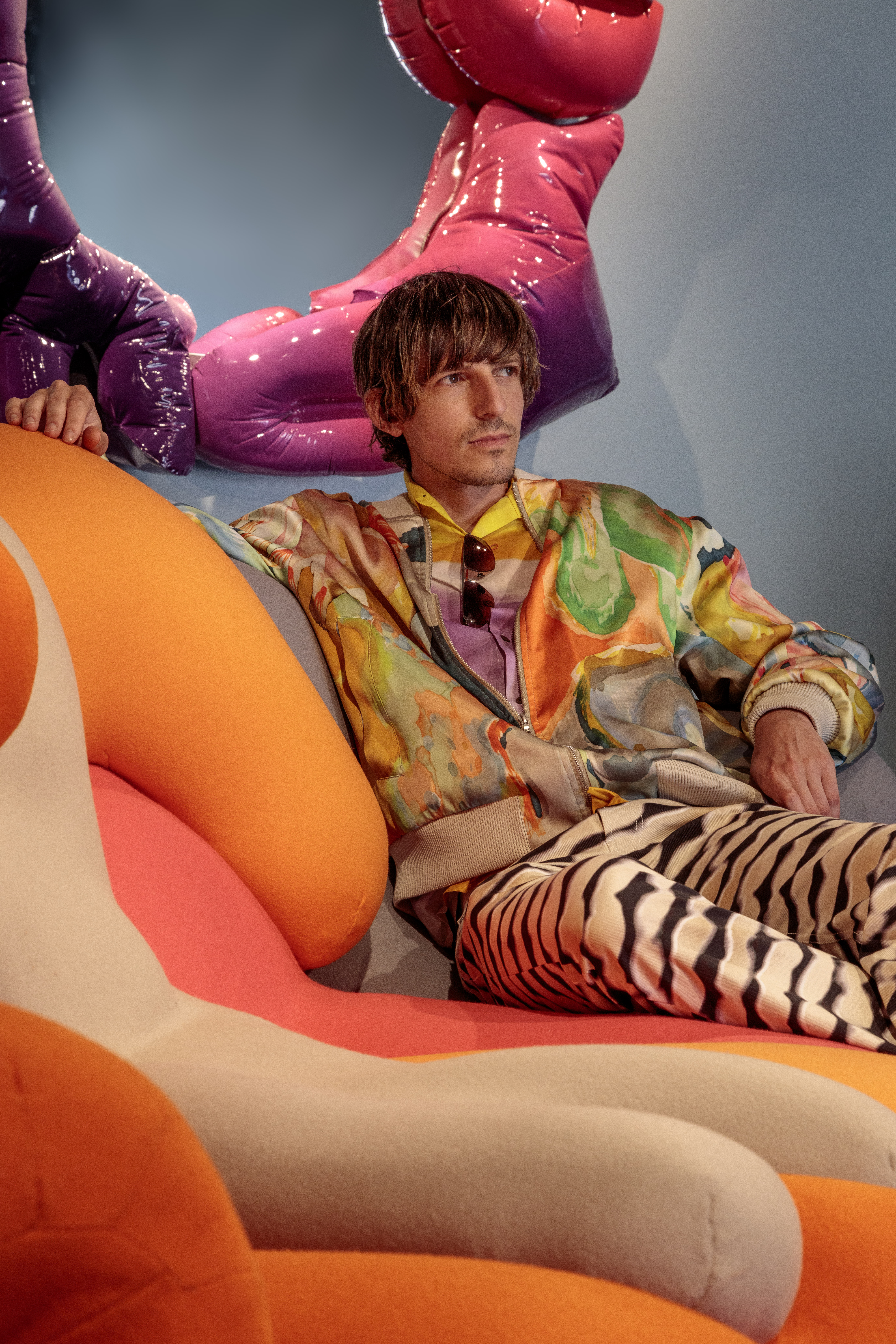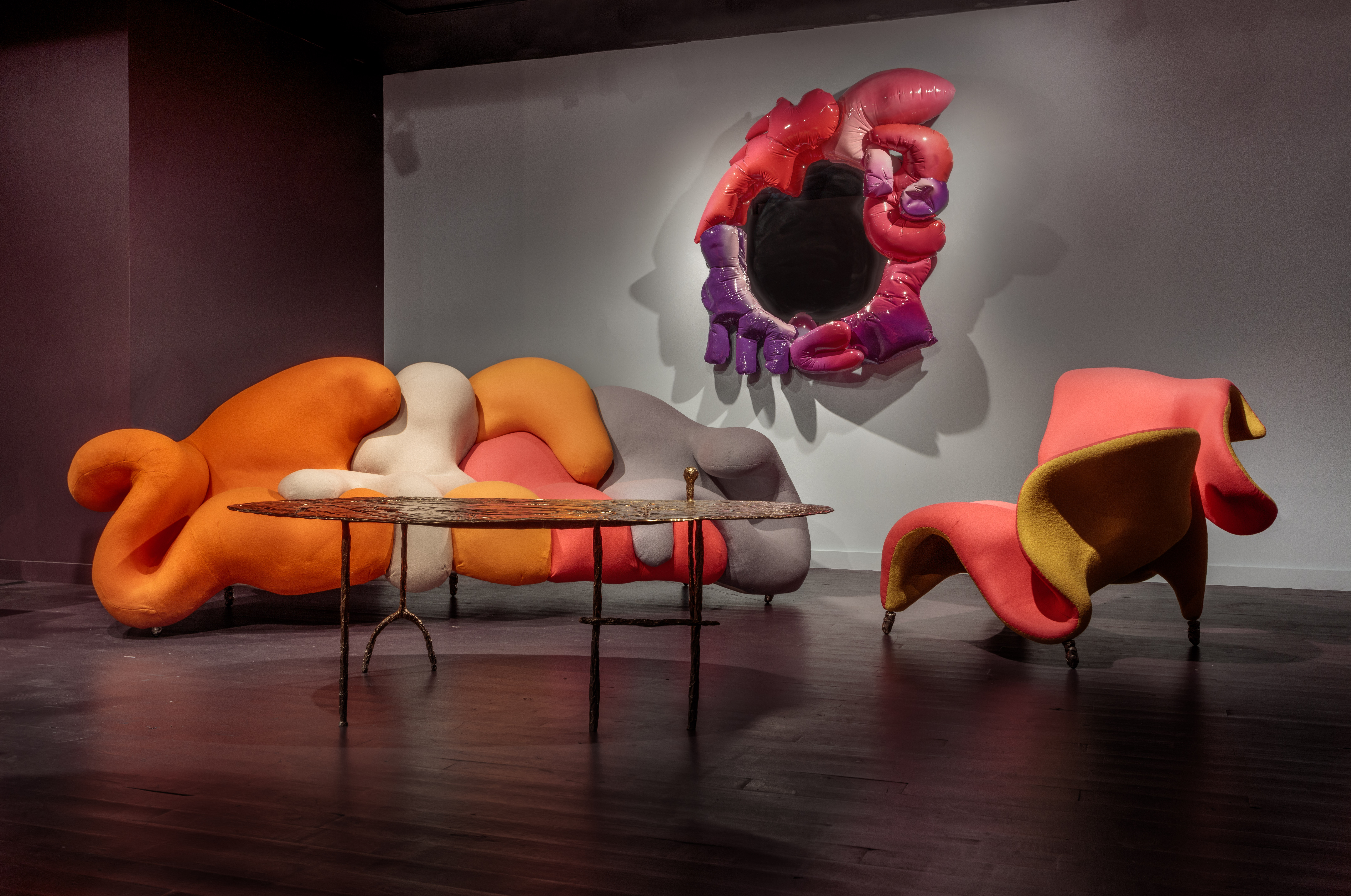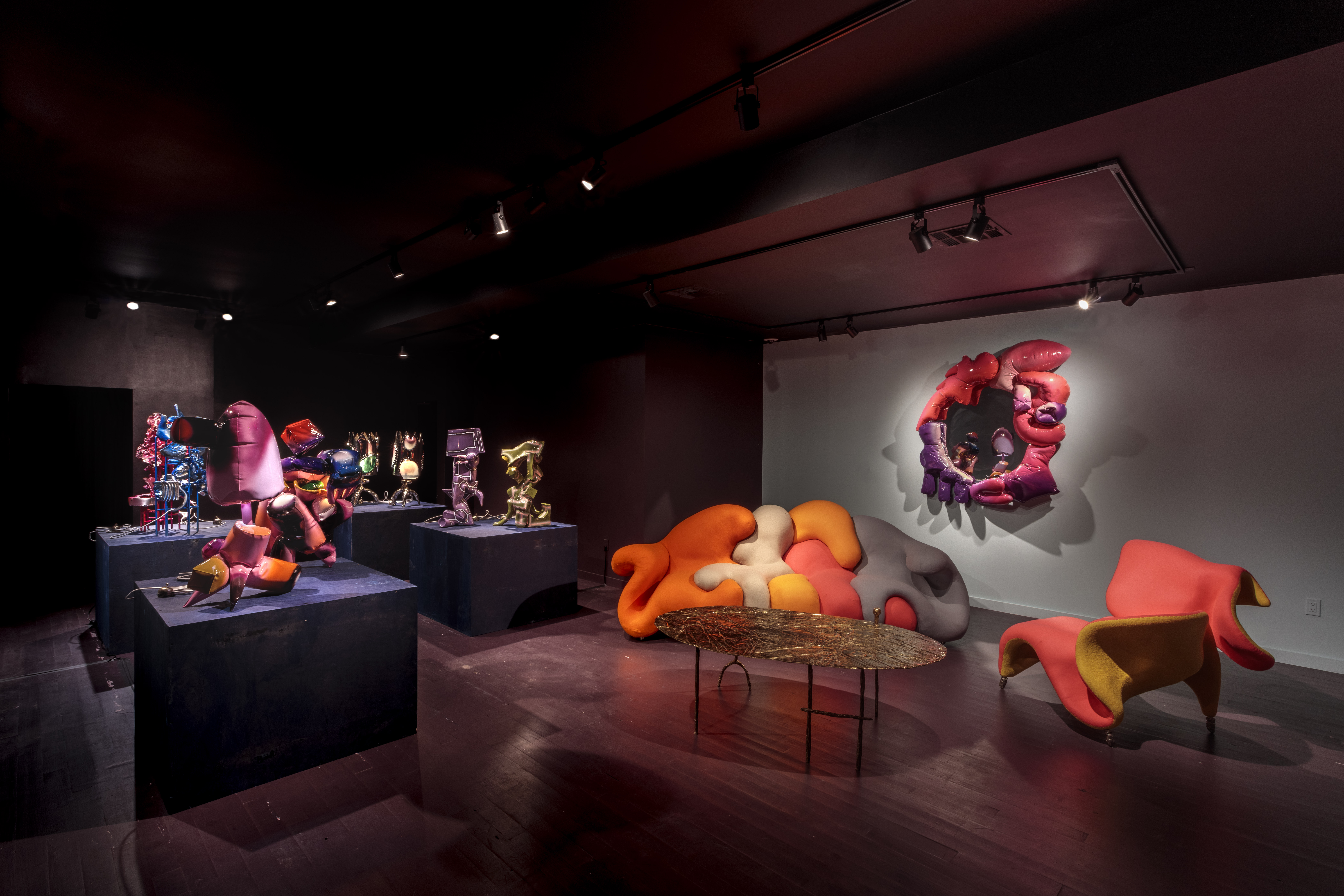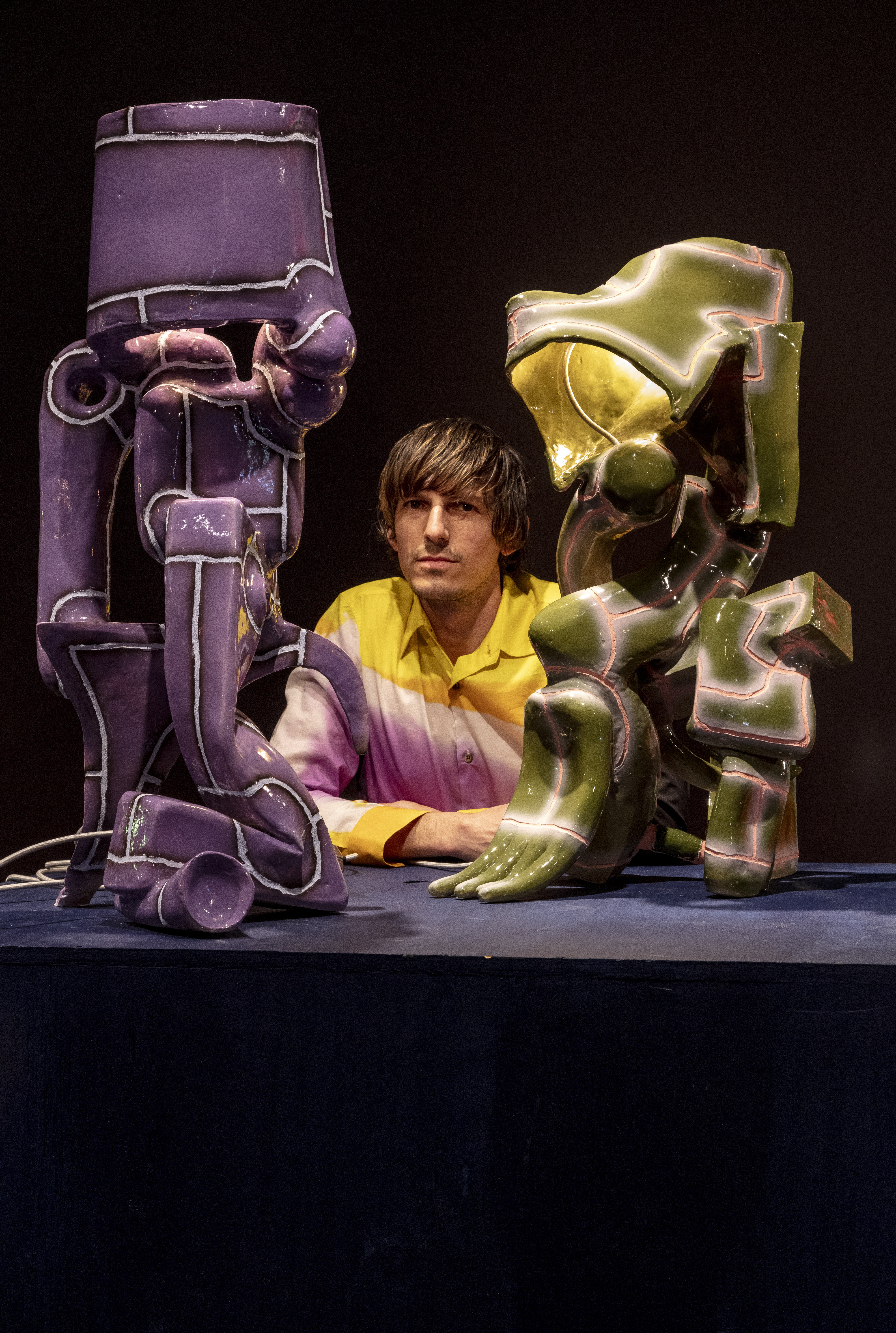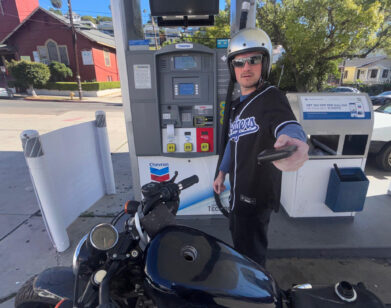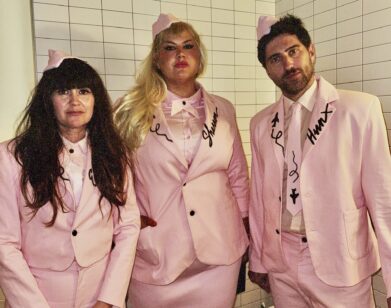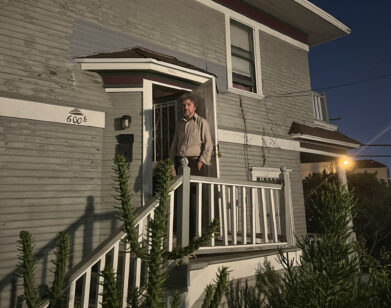in conversation
Misha Kahn and Dries van Noten Create “Organized Craziness”
Misha Kahn and Dries van Noten are two visual explorers hailing from different generations and mediums—one transforms furniture into acid-tinted creatures that are nearly unidentifiable as home decor, the other turns clothing into wearable abstract art. With their shared surrealist vision of the world, it only makes sense that the 62-year-old Belgian fashion designer and the 32-year-old American sculptor meshed their talents. Van Noten invited Kahn to exhibit his latest work at The Little House, an extended space in the designer’s first American brick-and-mortar store on La Cienega Boulevard in Los Angeles. As part of Kahn’s show, titled “Watermelon Party,” the duo also released a limited-edition printed silk bomber jacket (worn by Misha above) and a t-shirt. On the occasion of their colorful collaboration, Kahn and van Noten connected via Zoom, in New York and Belgium respectively, to talk about the process of creating “organized craziness,” the importance of visiting a store IRL, and the booziest ways to eat watermelon.
———
DRIES VAN NOTEN: Where are you now, Misha?
MISHA KAHN: I’m back in New York in my studio.
VAN NOTEN: I am in Belgium in the office building here in our studio, which is a mixture, in fact, of the warehouses and offices and the studio. So it’s all in one big building, which is easy. It’s very hands-on for a lot of designers. Quite often, everything is quite done remotely.
KAHN: I think you see it in the end thing. It’s hard if you can’t have your fingers on things to really control them quite as much. I feel like anytime we try and make a piece, it takes so long. But the people from your team who are working on the jacket, they’re like, “Oh, send us the imagery,” and seven days later, the jacket is done.
VAN NOTEN: It is not always going to be like that. Once we made them, originally, there was still the idea to touch them up, but I liked them already the way that they were. So I thought, “Let’s keep them like this because the risk that we’re going to spoil them by putting hand paint on it would be bigger—and they were already very nice.” I don’t know if you’ve seen, but LeBron James was wearing the t-shirt. Did you see it?
KAHN: No way! That’s amazing. I guess it will probably sell pretty well.
VAN NOTEN: The thing is that I knew your work from social media. I was really intrigued by it because there is that very, shall I say, organized craziness. There is craziness, but with reason. There was something I really liked about that, because I think when I do color combinations and material combinations, and shapes, there is something which I try to, on one hand—control it, but on the other hand, let it free. I think that resonated in your work.
KAHN: I’m always striving to do something kind of similar to what I think you’ve been achieving in your work for so long, which is to not forget about any of the parts. You have a surface that can have something magical happening, and the form can be something different or related, and you touch on all these different aspects. I feel like somehow you manage to pull in vaguely historical-looking things, but still make it look futuristic, which is another trait that I’m trying to nail. To have some references that people can get into, but take it somewhere that actually feels new.
VAN NOTEN: I always say that I have a lot of respect for the past. There’s always a hint to something which has been, but I’m not nostalgic. It’s not that I want to copy the past, but I do want to learn from it and push it to the future. I think that’s an important thing. We are not living in the 19th century. We are looking forward—that is the key. What I like in your work is that you clearly have the craft skills—the bronze, the material, the way that they are treated, how perfectly everything is made. I think that also gives strength to it because you feel that there is kind of, in French you say savoir faire, I don’t know how you translate it in English.
KAHN: I suspect it’s kind of similar. The expression can be a little flippant. If the piece is made really nicely, it has some gravitas to it. People know that you meant it, even if it’s a little bit silly or fun.
VAN NOTEN: Exactly. Sometimes it’s quite complicated. But on the other hand, when you see the final result, I’m really happy with it. And then, you forget the technical and the more boring parts and you just go for the look. The big celebration of our creativity is always a fashion show. And now, of course, there are no more fashion shows. So that’s changing a lot for us also.
KAHN: Are you excited about an alternative, or are you anxious for a fashion show?
VAN NOTEN: Both at the same time. On one hand, of course, I’m being pushed out of my comfort zone because we can’t end the creative circle of the collection with the fashion show. But on the other hand, we’re forced now to look for other ways to express, evoke emotion, share things with people, and explain things to people. I still want to do fashion shows in the future once this whole thing is going to be over, if it’s ever going to be over, but in the meantime, I don’t want to go back to where we were. The whole fashion circus, I don’t need it anymore. In that way, I think there’s going to be an evolution. I think difficult times can be interesting because you’re forced to think out of the box and you have to forget everything you learned and you just have to see.
KAHN: I feel like everyone’s going to be really excited to go out and go dancing. They’ll be shopping for good looks. I was so excited about the possibility of getting to work on some clothes. I was pestering, asking about it in every email.
VAN NOTEN: I was very happy because of course, we love colors. We love prints. We are spoiled with our manufacturers because everything went very fast, very smooth. We have a very good collaboration with ateliers in Como, Italy, who work in a very specific way by scanning garments, opening, painting, touching up and all those things. They are really experts in that. Of course, it was also a nice thing because the Little House is a very nice little side project that we have in the store in L.A. To be able to extend that to you was really a very fun opportunity.
KAHN: Are you experimenting with it in other places as well?
VAN NOTEN: No. With the store in L.A., I just wanted to prove that there is still life for brick-and-mortar stores. Everybody, especially now with the Corona crisis, is saying, “Oh, everything is now e-comm, and everything has to be digital.” I really wanted to prove that there is still a future for the brick-and-mortar store. I think that it’s really possible to do things, exciting things, that people can still travel to the store to see things and to discover. The Little House is one of those elements. We have vinyl records in the store, we have artists painting on the walls. We have all those different things happening. You don’t have to come for the clothes. You can just enjoy a nice time and leave. You can learn, you can see books, records, and art. Reactions have been really positive.
KAHN: With my shows, I am always kind of thinking about how to make it enough of an event that people can kind of center their day around it. I think you definitely achieved that with that space, too. It feels like you really have to meander through all of these rooms. It’s about so many things that are tactile. If you don’t experience it in person, you really are only getting one little part of it, which is hard because I feel like everyone now is trying to find ways to do everything through pictures, and online viewing rooms, and virtual facsimiles. You definitely lose something.
VAN NOTEN: For me, when everything is too organized and too digital, you lose the coincidence. I love going to stores. You’re looking maybe for a navy sweater and you come out with something bright yellow. Maybe you go in for a sweater and you come out with a piece of Misha Kahn furniture. Those are the things which I like. I think if you’re looking for a plain navy sweater, go to the internet. If you want to be surprised, go to a real store.
KAHN: Well, maybe you’re the right person to design the online shopping platform with a really messy algorithm. I feel like this year everyone thought it was a nice time for creatives. But I was basically miserable. All of my ideas kind of come from being around friends and seeing lots of things and just consuming the world, and so I found it very uninspiring. How was it for you?
VAN NOTEN: Kind of the same, because I love to travel. I love to go to museums, galleries, and all those things. Of course, on one hand, it’s okay that you have more time to be creative. But on the other hand, for me, working on a collection is really teamwork, and I love to be around with my creative team, talking with them, hanging out, drinking a glass of wine in the evening. You see, moments like that are the best creative moments. And all those things were not possible now. For my print design, it’s really important that I can talk about the nuance of color, but with the face mask, you see only your eyes. So you have to invent new words because normally, in your mouth you see already if you like something or you hate something.
KAHN: Or the nuance in between. That’s the part you lose.
VAN NOTEN: Anyway, we still have to continue. I think America is doing the vaccines much better than we are, but I hope to get my vaccine next month. So let’s cross my fingers. I saw some of your questions and there was a rather strange one, which is: What is your favorite way to eat watermelon? Who invented that question?
KAHN: Someone asked this morning, “You didn’t make one of those watermelons where you stick a bottle of booze in it for the opening—what were you thinking?” Which seemed like the most American way to eat a watermelon.
VAN NOTEN: It’s also very, very European, with vodka. I don’t know what you put in it normally, but here it’s vodka.
KAHN: I guess I imagine ours with a particular sort of American yard surrounding. But somehow when I re-imagine that watermelon in Europe, it’s on a beautiful wood boat, going down a canal somewhere with, like, a nice linen. I think any way to eat watermelon is nice. I like that people have to spit constantly. Like, it’s the rare time that we eat something and we’re just constantly spitting, which is this sort of vulgar and nice feeling.
VAN NOTEN: You can’t do it in an elegant way. You can’t do it with a knife and fork. That’s the thing.
KAHN: There’s no getting around it.

